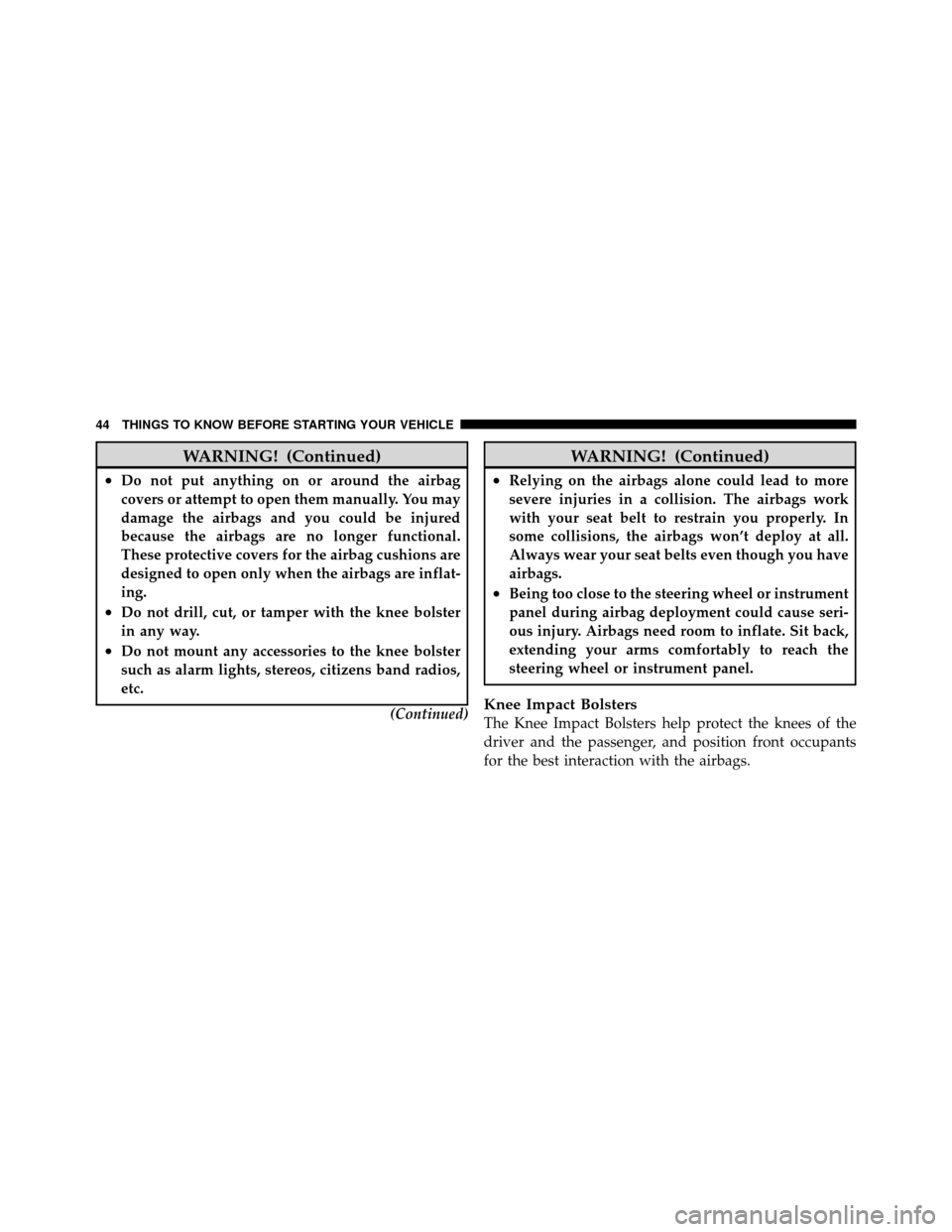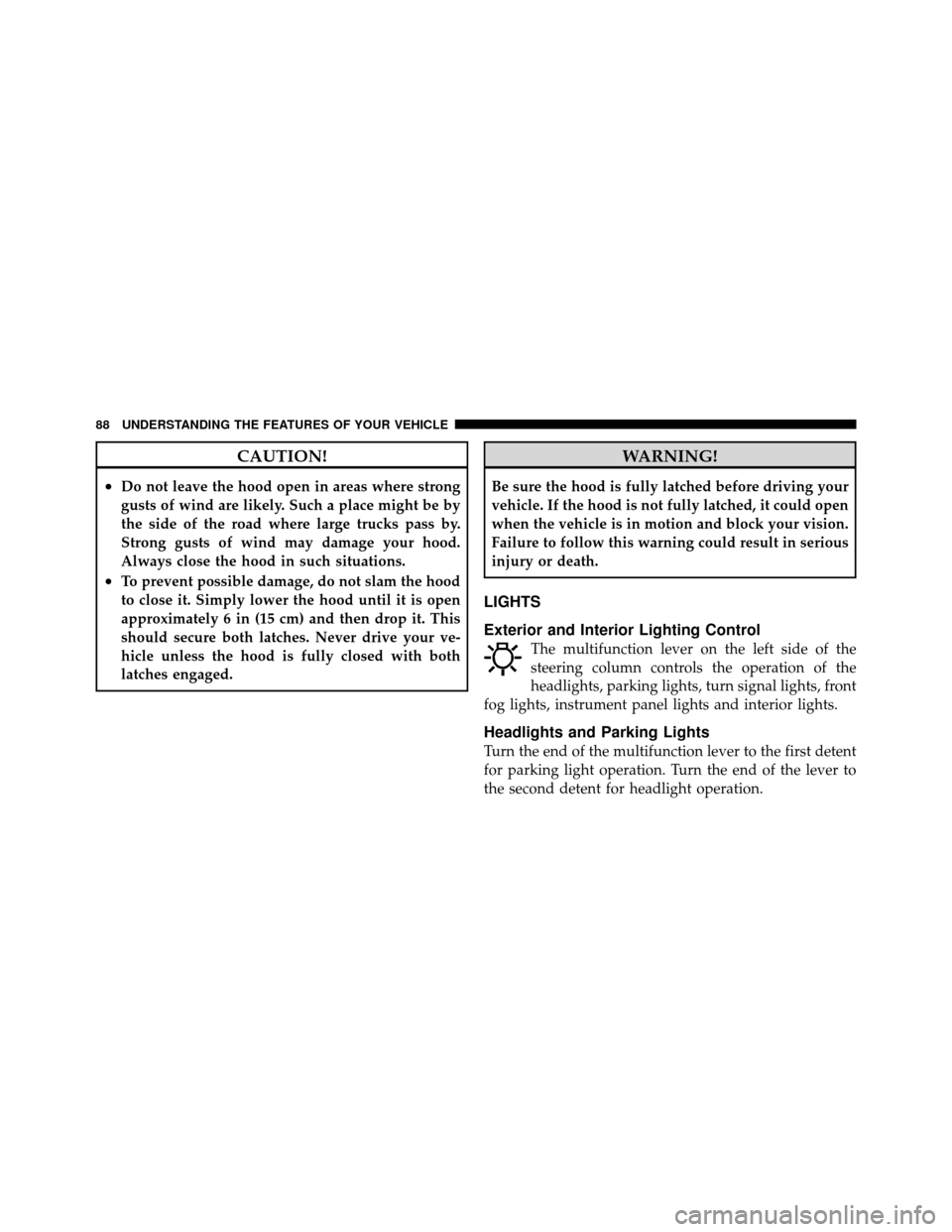Page 35 of 315

Gas props support the liftgate in the open position.
However, because the gas pressure drops with tempera-
ture, it may be necessary to assist the props when
opening the liftgate in cold weather.
TRUNK LOCK AND RELEASE — CONVERTIBLE
MODELS ONLY
You can unlatch the trunk lid by pressing the TRUNK
button on the Remote Keyless Entry (RKE) transmitter
for at least one second. The park lights and turn signal
lights will flash three times to acknowledge the signal
and the trunk lid will pop open.
You can also unlatch the trunk lid with the key. The key
cylinder is located on the trunk lid.
The word “DECK” will flash in the odometer when the
trunk lid is open. With the key in the ignition switch, this
display will turn off approximately 40 seconds after
switching OFF the ignition, or if the Power AccessoryDelay feature is active, it will turn off approximately
40 seconds after the delay feature times out.
NOTE:
Gas props support the trunk lid in the open
position. However, because the gas pressure drops with
temperature, it may be necessary to assist the props when
opening the trunk lid in cold weather.TRUNK SAFETY WARNING — CONVERTIBLE
MODELS ONLY
WARNING!
Do not allow children to have access to the trunk,
either by climbing into the trunk from outside, or
through the inside of the vehicle. Always close the
trunk lid when your vehicle is unattended. Once in
the trunk, young children may not be able to escape.
If trapped in the trunk, children can die from suffo-
cation or heat stroke.
2
THINGS TO KNOW BEFORE STARTING YOUR VEHICLE 31
Page 48 of 315

WARNING! (Continued)
•Do not put anything on or around the airbag
covers or attempt to open them manually. You may
damage the airbags and you could be injured
because the airbags are no longer functional.
These protective covers for the airbag cushions are
designed to open only when the airbags are inflat-
ing.
•Do not drill, cut, or tamper with the knee bolster
in any way.
•Do not mount any accessories to the knee bolster
such as alarm lights, stereos, citizens band radios,
etc.(Continued)
WARNING! (Continued)
•Relying on the airbags alone could lead to more
severe injuries in a collision. The airbags work
with your seat belt to restrain you properly. In
some collisions, the airbags won’t deploy at all.
Always wear your seat belts even though you have
airbags.
•Being too close to the steering wheel or instrument
panel during airbag deployment could cause seri-
ous injury. Airbags need room to inflate. Sit back,
extending your arms comfortably to reach the
steering wheel or instrument panel.
Knee Impact Bolsters
The Knee Impact Bolsters help protect the knees of the
driver and the passenger, and position front occupants
for the best interaction with the airbags.
44 THINGS TO KNOW BEFORE STARTING YOUR VEHICLE
Page 57 of 315

•At no time should any supplemental restraint system
(SRS) component or SRS related component or fastener
be modified or replaced with any part except those
which are approved by Chrysler Group LLC/Mopar�.
WARNING!
Unapproved modifications or service procedures to
the passenger seat assembly, its related components,
or seat cover may inadvertently change the airbag
deployment in case of a frontal crash. This could
result in death or serious injury to the passenger if
the vehicle is involved in a collision. A modified
vehicle may not comply with required Federal Motor
Vehicle Safety Standards (FMVSS) and/or Canadian
Motor Vehicle Safety Standards (CMVSS).
Enhanced Accident Response System
In the event of an impact causing airbag deployment, if
the communication network remains intact, and the
power remains intact, depending on the nature of the
event the ORC will determine whether to have the
Enhanced Accident Response System perform the follow-
ing functions:
•Cut off fuel to the engine.
•Flash hazard lights as long as the battery has power or
until the ignition key is turned off.
•Turn on the interior lights, which remain on as long as
the battery has power or until the ignition key is
removed.
•Unlock the doors automatically.
If a Deployment Occurs
The front airbags are designed to deflate immediately
after deployment.
2
THINGS TO KNOW BEFORE STARTING YOUR VEHICLE 53
Page 71 of 315

WARNING! (Continued)
•Always make sure that objects cannot fall into the
driver foot well while the vehicle is moving.
Objects can become trapped under the brake pedal
and accelerator pedal causing a loss of vehicle
control.
•If required, mounting posts must be properly
installed, if not equipped from the factory.
Failure to properly follow floor mat installation or
mounting can cause interference with the brake
pedal and accelerator pedal operation causing loss
of control of the vehicle.
Periodic Safety Checks You Should Make Outside
the Vehicle
Tires
Examine tires for excessive tread wear and uneven wear
patterns. Check for stones, nails, glass, or other objectslodged in the tread. Inspect the tread and sidewall for
cuts and cracks. Check the wheel nuts for tightness.
Check the tires (including spare) for proper pressure.
Lights
Have someone observe the operation of exterior lights
while you work the controls. Check turn signal and high
beam indicator lights on the instrument panel.
Door Latches
Check for positive closing, latching, and locking.
Fluid Leaks
Check area under vehicle after overnight parking for fuel,
engine coolant, oil, or other fluid leaks. Also, if gasoline
fumes are detected or if fuel, power steering fluid, or
brake fluid leaks are suspected, the cause should be
located and corrected immediately.
2
THINGS TO KNOW BEFORE STARTING YOUR VEHICLE 67
Page 73 of 315
UNDERSTANDING THE FEATURES OF YOUR VEHICLE
CONTENTS
�Convertible Top Operation — If Equipped ..... 71
▫ To Lower The Top ..................... 71
▫ To Raise The Top ..................... 73
▫ Convertible Top Boot Cover Installation —
If Equipped ......................... 75
▫ Convertible Top Boot Cover Removal And
Storage ............................ 79
� Mirrors .............................. 82
▫ Inside Day/Night Mirror ................ 82
▫ Outside Mirrors ...................... 83 ▫
Power Mirrors ....................... 84
� Seats ............................... 85
▫ Manual Seat Adjustments ............... 85
� To Open And Close The Hood ............. 86
� Lights .............................. 88
▫ Exterior And Interior Lighting Control ...... 88
▫ Headlights And Parking Lights ........... 88
▫ Headlight Time Delay .................. 89
▫ Daytime Running Lights ................ 89
3
Page 74 of 315
▫Lights-On Reminder ................... 90
▫ Battery Saver Feature — Exterior Lights ..... 90
▫ Fog Lights .......................... 90
▫ Turn Signals ......................... 91
▫ High Beam/Low Beam Select Switch ....... 91
▫ Flash-To-Pass ........................ 91
▫ Interior Lights ....................... 91
� Windshield Wipers And Washers ........... 94
▫ Intermittent Wiper System ............... 95
▫ Mist Feature ......................... 96 ▫
Windshield Washers ................... 96
� Tilt Steering Column .................... 96
� Adjustable Pedals ...................... 97
▫ Adjustable Foot Rest ................... 99
� Electrical Power Outlets ................. 100
� Console Features ...................... 102
� Storage ............................. 103
� Rear Window Features .................. 104
▫ Rear Window Defroster ................ 104
70 UNDERSTANDING THE FEATURES OF YOUR VEHICLE
Page 92 of 315

CAUTION!
•Do not leave the hood open in areas where strong
gusts of wind are likely. Such a place might be by
the side of the road where large trucks pass by.
Strong gusts of wind may damage your hood.
Always close the hood in such situations.
•To prevent possible damage, do not slam the hood
to close it. Simply lower the hood until it is open
approximately 6 in (15 cm) and then drop it. This
should secure both latches. Never drive your ve-
hicle unless the hood is fully closed with both
latches engaged.
WARNING!
Be sure the hood is fully latched before driving your
vehicle. If the hood is not fully latched, it could open
when the vehicle is in motion and block your vision.
Failure to follow this warning could result in serious
injury or death.
LIGHTS
Exterior and Interior Lighting Control
The multifunction lever on the left side of the
steering column controls the operation of the
headlights, parking lights, turn signal lights, front
fog lights, instrument panel lights and interior lights.
Headlights and Parking Lights
Turn the end of the multifunction lever to the first detent
for parking light operation. Turn the end of the lever to
the second detent for headlight operation.
88 UNDERSTANDING THE FEATURES OF YOUR VEHICLE
Page 93 of 315

Headlight Time Delay
This feature is particularly useful when exiting your
vehicle in an unlit area. It provides the safety of headlight
illumination for about 90 seconds after turning the igni-
tion switch OFF.To activate the delay, turn the ignition switch OFF while
the headlights are still on. Then, turn off the headlights
within 45 seconds. The delay interval begins when the
headlight switch is turned off.
If you turn the headlights, parking lights, or ignition
switch ON again, the system will cancel the delay.
If you turn the headlights off before the ignition, they will
turn off in the normal manner.
This feature can be disabled at the authorized dealership,
if so desired.
Daytime Running Lights
The fog lights will come on as Daytime Running Lights,
whenever the ignition switch is ON, the headlights are
off, and the parking brake is off. The headlight switch
must be used for normal night time driving.
Multifunction Lever
3
UNDERSTANDING THE FEATURES OF YOUR VEHICLE 89